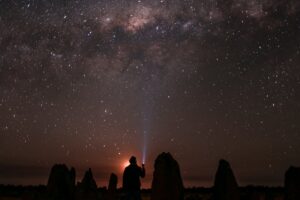
In a distant galaxy many, many millennia ago a star burst. It was not over in seconds, first its light glowed more brightly, more brilliantly but gradually the light dimmed back to more regular levels. Then there was a sudden blinding flash and the star disintegrated into atoms and molecules which sped outwards in the explosion.
The broken star’s energy travelled outwards leaving a void behind. The nearest planets were uninhabited by any life forms but the strength of the star’s destruction flattened their surface and pushed them away from their former orbits as they had no object left to circle. Culpash, a small planet was the only inhabited planet in the solar system. It had been partially covered by water. Both land and oceans had teemed with myriad life forms which fed on each other and the planet’s lush vegetation.
Sentient beings dwelt on the planet. Beings who had long been space travelers as their numbers had expanded past that which Culpash could support. Colonies had been established in further galaxies which thrived and sent out further groups to populate the universe.
The death of their star had been predicted many times but the predictions were all for millennia in the future. A few of those on the planet boarded spacecraft racing away, leaving behind billions who died on a cooling light-less planet. All the bounding life on the planet and the vegetation was exterminated by the star’s death. Water was evaporated into space so only bacteria and microscopic life continued for a little while until they were frozen into stasis.
Some millennia before the star exploded an energy worm had glided gently down to the star’s incandescent surface and sunk deep within. The almost translucent mole entered the star unseen by the astronomers of Culpash and settled in the star’s core. The mole resembled more a caterpillar with all the legs at the head end with the addition of transparent skin sheets each side of the bulging gravid body with which it could direct its glide.
The head was basic, it had no eyes and a suction tube instead of a mouth. The intelligence of the beast was little, following born instincts rather than deliberate thoughts. Once inside the star the pregnant entity would fall inert drawing deeply of the star’s energy. This would be the finale of the worm’s existence as she gave birth to thousands of tiny energy worms identical to herself.
Over the years the baby worms would suck up the energy which had already dissolved their mother’s corpse until their consumption resulted in the star’s destruction. Then as the explosion pushed outwards away from the empty site of the burst star, the larval worms would travel unseen with the power of the star’s last burst. The planets were sucked towards the nearest surviving stars to form fresh orbits. The galaxy split as the dead star’s planets were drawn to two major stars on either sides of the former galaxy.
The rest of the star’s force hurtled on, causing chaos and change as it passed through other galaxies, carrying the tiny worms onward. They would consume space dust, energy and detritus until they reached a size when they would bear young, then they would seek out another star and cause its demise.
The star’s force drew smaller bodies with it as it traveled onward. As the energy moved on it slowed but dragged pieces of space refuse with it. Sentient constructed satellites and hulks of broken spacecraft joined the exodus outwards across the universe.
Many of the energy worms would not reach adulthood, some would be eaten by other space beasts including other moles and even their siblings, some would be sucked into the engines of spacecraft and others would be broken in asteroid storms. There were many dangers that might reduce their numbers but some would survive.
Over millennia much of the original star’s dust reached other space bodies. Some of the larval worms passed through a galaxy known as the Milky Way. Several large asteroids which had been pushed by the explosion’s impetus continued onward to collide with a particular dwarf white star, one which was orbited by nine planets including an inhabited planet whose occupants named her Earth.
Smaller meteorites hit the planet, causing deaths, tidal waves and catastrophic fires but the human race survived. Some of the larger pieces passed by the dwarf white star. One of the now larger energy worms glided down. Millennia passed and the sun glowed brighter and shone brilliantly and then the star burst.
by Giselle Marks, UK